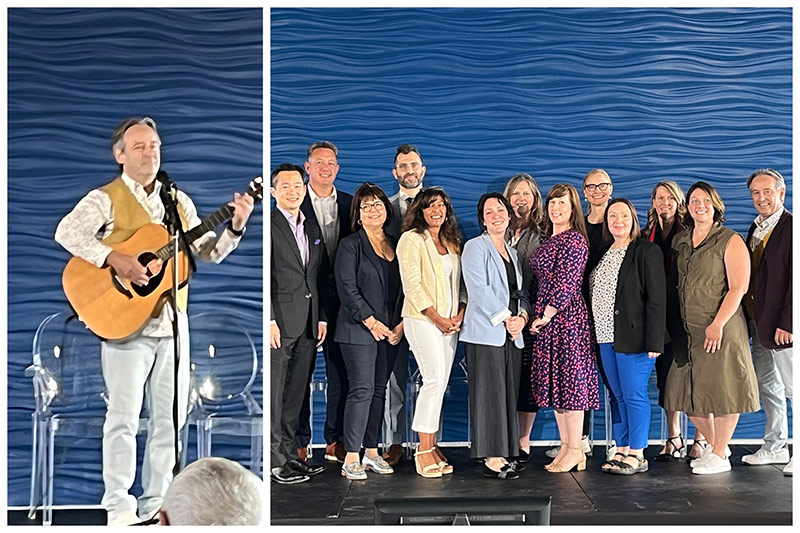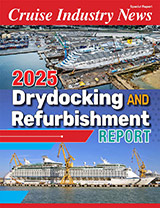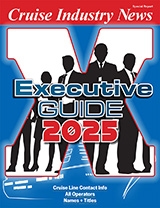René Trépanier, executive director of Cruise the Saint Lawrence, strummed through three tunes about the association’s formation, weathering the pandemic, and his wishlist for future cruising at the opening ceremony of the Cruise Canada and New England Symposium in New York Wednesday.
Building cruise traffic in socially and environmentally sustainable ways, community engagement, and the long term health of cruise ports were major themes at the symposium being held this week at the Manhattan Cruise Terminal.
Putting the guitar aside, Trépanier urged cruise lines to keep ports of call in the minds of passengers. Informing guests about the areas they’re sailing is a good way of enticing them to return, he said.
“We are just one circle in the chain right now, in the middle. But we want to be part of every link in the chain from the first to the end,” he said.
Lowering shore excursion prices — some of which are marked up 150 percent by the cruise line — could increase the number of guests getting cultural information through guided tours. This includes greater emphasis on what passengers want, including better informing them about meeting their environmental concerns.
“The shore excursion (rate) is only 40 percent as an average. We have 60 percent independent passengers disembarking in our ports,” Trépanier said. “The future is the client, the passenger choosing destinations with environmental responsibility.”
Lauren Gleason chief administrative officer for maritime at Massachusetts Port Authority said buying local was increasingly an environmental choice by passengers. Ports and cruise lines needed to spread out to areas less frequently visited by tourists to avoid overloading hot spots, she said. Gleason worked to encourage tours through Boston’s Roxbury and Jamaica Planes areas.
Jennifer Marmanillo, director of itinerary planning at Norwegian Cruise Line holdings, said her cruise line was adjusting to both trends, keeping environmental concerns, like whale zones, in mind when planning itineraries, and helping passengers find the truly local elements in ports of call.
New tours were vital to engaging passengers, she said.
“We get a lot of repeat guests so they need new things to see,” Marmanillo said, with selfie tours, cooking tours, mural tours, and more gaining popularity.
“They’re just city tours but they’re called selfie tours and now everybody wants to buy one,” she said. “You take the pictures yourself, of yourself.”
“A popular product in the Canada and New England region is open-jaw cruising, where guests can choose the port where they want to embed themselves longer than a few hours,” she said.
“People want to get more immersed into local cultures,” Marmanillo said. “There’s a lot of experience available with open-jaw cruising because you can get more port content.”
By contrast, she and Thomas Hinderhofer, senior director of terminal operations at systems at Royal Caribbean Group, said demand for private destinations remained high.
Hinderhofer joked it needn’t be limited to the Caribbean.
“Perfect day St. Lawrence, I mean why not,” he said, drawing laughs from the industry professionals gathered.
There’s also the question of how to increase the perception of cruising as beneficial to a port, and not just the cause of traffic congestion.
Sarah Flink, executive director of Cruise Maine; Robert Mercure, general manager of Destination Quebec Cit;, Alix Pierce, visitor itinerary director of the City and Borough of Juneau; and Danielle Timmons, vice president of cruise operations and shore excursions for Aquila Center for Cruise Excellence, all said a healthy relationship between residents and visitors was vital.
While Juneau represented a successful integration of local community and cruise interests, they said, Bar Harbor was a slip up, full of missed opportunities that led to disgruntled residents setting a passenger limit of 1,000 a day.
“We’ve got this cautionary tale of what happens when you lose social acceptability,” Flink said. Without constant communication about cruise’s benefits, local populations may only assume its detriments.
“You have to tell the story and you have to tell it again and again and again. If there is a pain point, let them know you are working on it.”
Juneau, on the other hand, took dramatic steps to survey and engage its residents, include them in decision making, and work to resolve potential infrastructure choke-points before they became a problem.
Old Quebec City was walking a similar tightrope, said Mercure. In 2019, rogue residents hung signs reading Tourists Go Home.
“Similar to Venice and Barcelona and Dubrovnik, there was a real issue that Old Quebec would become a dead city center,” he said. “The issue was to change the political discourse and really get into a much more collaborative discussion with the residents. We wanted to remove the most important irritants that were really mobilizing people’s complaints.”




